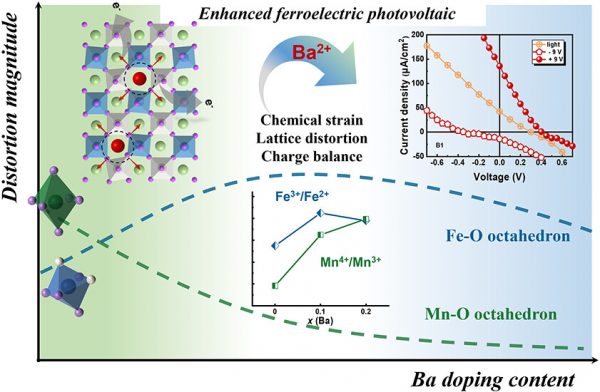Colossal Ferroelectric Photovoltaic Effect in double perovskites
- The researcher Yue-Wen Fang in the Quantum Theory of Materials Group at Centro de Física de Materiales (CSIC-UPV/EHU), together with the experimental team led by Linxing Zhang at the University of Science and Technology Beijing reported the discovery of a giant ferroelectric photovoltaic effect of 135.67 μA per square centimeter in engineered double perovskites Bi2FeMnO6, which is the highest recorded in ferroelectric thin films with a thickness of less than 100 nm under white-light LED irradiation.
- The research findings have been published online in the Journal of the American Chemical Society.
Ferroelectric materials have attracted much attention because of the photovoltaic mechanism that is different from that of the conventional semiconductor P–N junction cell. The spontaneous polarization of the noncentrosymmetric structure allows the separation of photogenerated carriers to be no longer confined to the junction, but to occur throughout the thin film interior, which permits the voltage to exceed the bandgap (Eg) limit. Theoretically, the power conversion efficiency of photovoltaic cells with ferroelectric materials as absorber layers is expected to exceed the Shockley–Queisser limit.
The researchers in this study have used a synergistic strategy to induce chemical strain and charge compensation through inequivalent element substitution. Specifically, the A-site substitution of the barium ion is used to modify the chemical valence and defect density of the two B-site elements in Bi2FeMnO6 double perovskite thin films.

Figure: Schematic representation of defect, strain, and charge transfer effects affecting the distortion of Fe/Mn–O octahedra in thin films with increasing Ba content. The blue solid curve indicates the tilted path of the Fe–O octahedron with oxygen vacancy density, and the green dashed curve indicates the weakened path of the distortion of the Mn–O octahedron. The inset figures show the crystal structure, the trend diagram of Fe and Mn elemental valence states of B site elements, and the current density as a function of voltage.
High-resolution HAADF-STEM, synchrotron-based X-ray diffraction and absorption spectroscopy, and density functional theory calculations collectively demonstrate that inequivalent ion plays a dual role of chemical strain (+1.92 and −1.04 GPa) and charge balance, thereby introducing lattice distortion effects which are shown in Fig. 1. The reduction of the oxygen vacancy density resulted from the introduction of Ba, and the competing Jahn–Teller distortion of the oxygen octahedron are the main phenomena of the change in electron–orbital hybridization, which also leads to enhanced ferroelectric polarization values and optical absorption. The ferroelectric polarization is found to effectively improve the photovoltaic efficiency of more than 5 times. Dramatically, the ferroelectric photovoltaic effect is increased to ∼135.67 μA per square centimeter from 30.62 μA per square centimeter, which is the highest in ferroelectric thin films with a thickness of less than 100 nm under white-light LED irradiation. The reseachers suggest that the inequivalent strategy can be extended to other double perovskite systems and applied to other functional materials, such as photocatalysis for efficient defect control.



